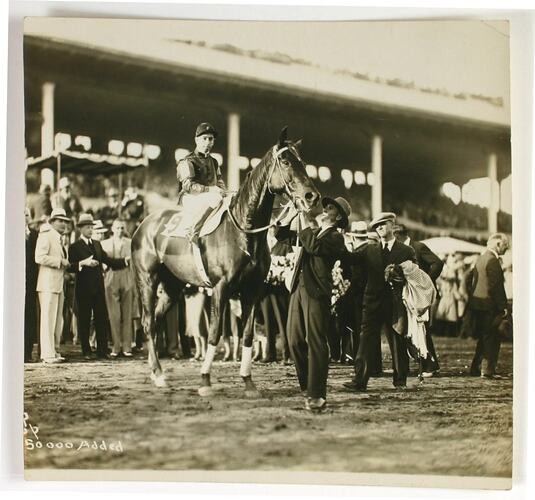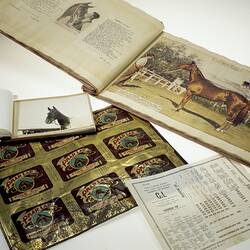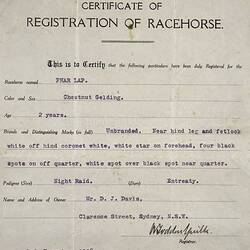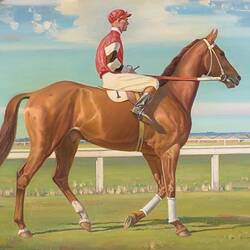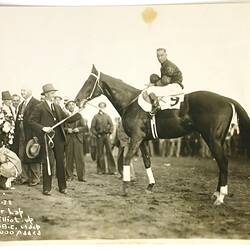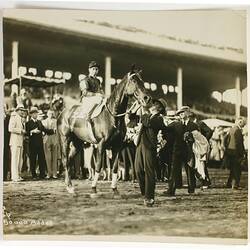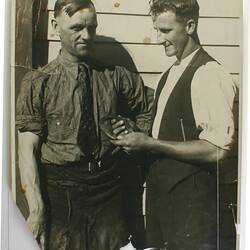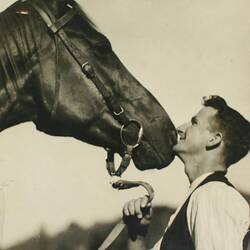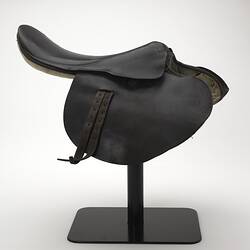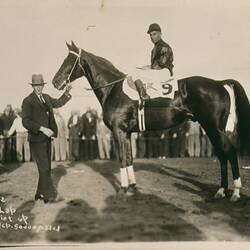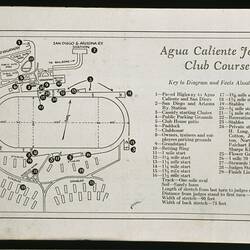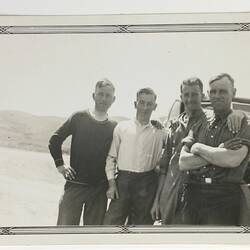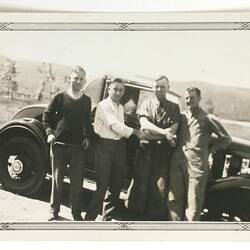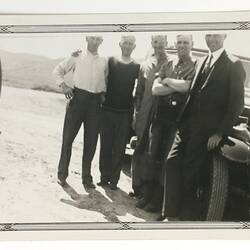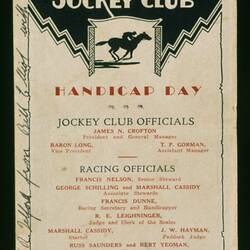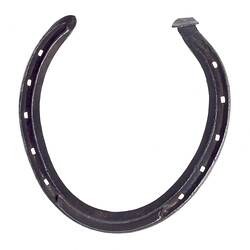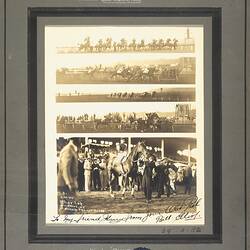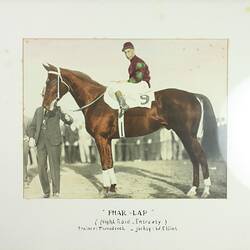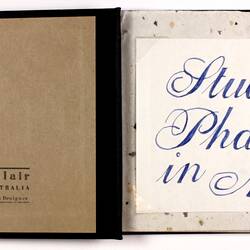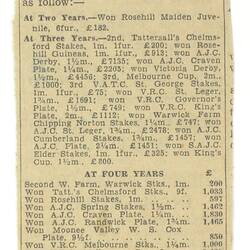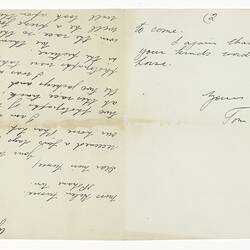By 1931, Phar Lap had won virtually every major Australian race, many of them twice. The next chapter in Phar Lap's life would consolidate his status as a national icon. The idea of taking 'Big Red' to the United States had been discussed among racing people for some time.David Davis proved the most enthusiastic supporter of the idea; hardly surprising given his American background and intentions of returning there.
Many Australians, meanwhile, had a dark sense of foreboding about the plans, but the decision was not theirs to make. Even Harry Telford, his trainer, initially had misgivings, feeling there were 'easy pickings' still to be made in Australian racing. He was to change his mind after a disappointing run in the 1931 Melbourne Cup, when a tired and unwell Phar Lap came home eighth, carrying a crushing weight of 10 stone 10 lbs (68 kgs).
The US offered a rich racing circuit, but the greatest single incentive was the Agua Caliente Handicap - America's richest race. Agua Caliente was actually in Mexico: a casino-resort complex set just over the border, south of San Diego. The prize money of US$100,000 ensured that Phar Lap would be up against America's best. This remained the case, despite a halving of the prize money several weeks before the race because of the Depression.
Telford had other horses to train, and so nominated Tom Woodcock to accompany the champ as both strapper and trainer. Originally Telford was to follow on a later ship, but he never made the voyage. On Friday 20th November 1931 Phar Lap sailed from Sydney Harbour.
The Sea Voyage
In reality, Telford had to send Woodcock. More than ever he had become like a security blanket for the horse. On the sea journey, Phar Lap even made it difficult for Woodcock to leave his sight long enough for a meal in the ship's dining saloon. A special stable had been built for Phar Lap on the deck - complete with a sandpit for him to roll in - but whenever Woodcock went below deck, 'Bobby' would create a fuss. Woodcock was forced to take his meals in the Boson's cabin on deck where Phar Lap could see him through the open doorway and to sleep by his stall.
The journey to America included a five week break in New Zealand, much enjoyed by the locals. New Zealanders had not forgotten where Phar Lap was foaled and made it clear they regarded him as a New Zealand champion.
Acclimatisation and Preparation
In the weeks leading up to the Agua Caliente Handicap, Australians listened, watched and read anything they could on Phar Lap's progress. Once in California, all Tom Woodcock's efforts were focused on acclimatising Phar Lap. There was a lot riding on the outcome of the Agua Caliente. If Phar Lap lost, Woodcock would get paid nothing other than his expenses for the trip. Money, however, was never Woodcock's primary interest. He just wanted 'Bobby' to show the Americans what he was made of.
One might imagine then how Woodcock felt when 'Bobby' trode on a stone and split a hoof just weeks before the race day on 20th March 1932. Many Americans believed that claims of an injured hoof were baloney. They thought the Australians were simply talking down their champ's chances so they could get better odds, but Woodcock was genuinely worried. A piece was cut from Phar Lap's hoof and a special shoe made to bridge the missing section. Considering there were ten other entrants in the Agua Caliente Handicap, the American media was surprisingly absorbed in Phar Lap. The 'Anzac Antelope' was one of the more absurd of the many nicknames he was given.
As he had been instructed before departing Australia, Woodcock kept the champ's toughest pre-race trackwork a secret so that the odds would stay good. A photograph taken at the Agua Caliente racetrack, dated 13th March, proves that Phar Lap was given a workout exactly one week before the race.
Race Day at Agua Caliente
On Sunday 20th March 1932, the big day had arrived. The Agua Caliente Handicap was scheduled for late in the day as the thirteenth race. Phar Lap, from an outside barrier, was one of the last away. This suited jockey Billy Elliot just fine. He had been warned not to get too close to the fence because other jockeys might block him for a run. Indeed, the Phar Lap camp knew that Mafia connections had a lot riding on the race and, rightly or wrongly, thought they might try any tactics to deny him the win.
Rounding the first turn, Elliot took Phar Lap out very wide to the centre of the track to avoid the dirt being thrown up by the field. It was then, as the turn straightened-up for a back stretch of about four hundred metres, that 'the fireworks started'. Phar Lap went from about second-last to gather up the entire field, finding the fence as the next turn commenced. Elliot then let the horse take it easy, holding his front position coming up to the hometurn. It was at this point, as Reveille Boy moved forward and momentarily got his head in front, that Phar Lap met his moment of truth.
It is sometimes said that true champions can produce two 'runs' within a race. Phar Lap's first run, along the back straight, was dazzling - amazing really. His second, to shake off Reveille Boy and the rest of the field, was delivered with authority. Elliot gave him no more than a nudge and in a couple of his giant strides Phar Lap put himself two, then three lengths in front.
The radio broadcast back in Australia was fairly rough, but people certainly got the right idea: Phar Lap had won the richest race on earth! There were tens of thousands of perfectly synchronised scenes of jubilation across the country. Never before had Australia experienced such a sense of live participation in an overseas sporting event.
After the race, as the champion was brought back to the winners' circle, the crowd of 50,000 witnessed the Australians' sense of relief and elation.
Related Resources:
Phar Lap - the Story of Australia's Wonder Horse
Phar Lap Infosheet
References:
Armstrong, Geoff & Thompson, Peter, 2000, Phar Lap, Allen & Urwin, Melbourne.
Reason, Michael, 2005, Phar Lap: A True Legend, Museum Victoria, Melbourne (revised edition 2009).
More Information
-
Keywords
-
Authors
-
Article types
